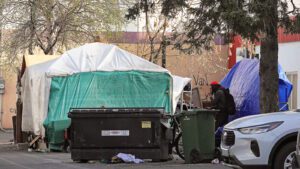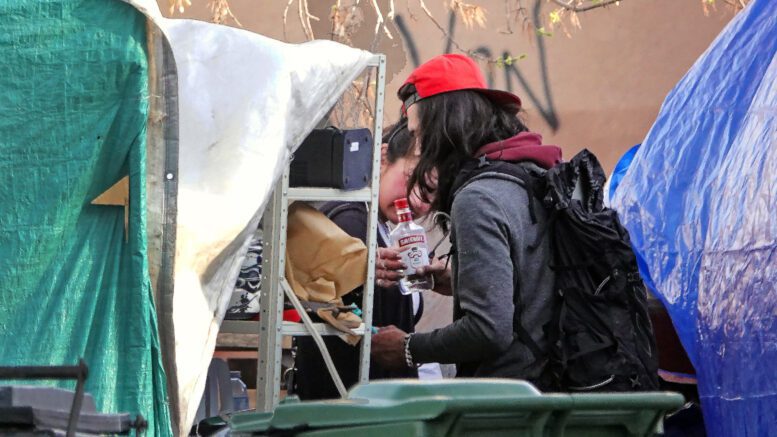“There’s no legal authority for us to remove an encampment. We can’t go down there with a bulldozer and knock it down. We have to work with the individuals who are staying there … help them find somewhere to stay, whether that’s a shelter, whether that’s a different location that’s not as disruptive to business and the general public downtown.”
– Premier R.J. Simpson
Authorities have few legal means to remove encampments, so the GNWT plans to have conversations, “working with their legal representation, and doing our best to find locations that might be more suitable,” Premier R.J. Simpson admitted in the NWT Assembly.
 “We want to ensure that we’re also working with the vulnerable population who’s living in these encampments,” the Premier said in response to questioning by Yellowknife Centre MLA Robert Hawkins.
“We want to ensure that we’re also working with the vulnerable population who’s living in these encampments,” the Premier said in response to questioning by Yellowknife Centre MLA Robert Hawkins.
“We want to ensure they’re in a place that is safe, that it’s not disrupting other nearby neighbours.
“We all have to get along, and we want to ensure that we’re working to minimize any type of conflict that might occur. That being said, we want to we don’t want to normalize encampments.”
While it wasn’t explained on Tuesday how or why homeless people living in a tent in a parking lot have legal representation, the Assembly has been recently told there are shelter spaces available and that the GNWT will allow camping on Commissioner’s land in and around the capital.
Said MLA Hawkins: “I’d like to find out what work with means, because the residents of that area, be it the neighbours with children, families, (entrepreneurs with) investments, businesses. They want to understand why are they being held hostage over people who have taken over a government parking lot that’s usually used for vehicles to park it while these people are stealing power and being set up quite nicely.
“And just to be clear, when I say held hostage, held hostage by the noise, the intensity, the regularity and the frustration that they can’t sleep and can’t live healthily, that’s what I mean about being held hostage, not physically bound.”

Structures at the homeless encampment behind the downtown Liquor Store at 6am Wednesday morning. It is also across the lane from the GNWT’s Sobering Centre. (James O’Connor/CKLB)
Hawkins said when the GNWT directly or through NGOs provides food, water, toilets, security, “then it becomes entrenched.”
The MLA asked, “what the Premier is doing or instructing through his government, through various departments, about removing the current encampment that’s downtown to a more appropriate place?”
Simpson’s reply: “The plan is to work with those individuals, help them find somewhere to stay, whether that’s a shelter, whether that’s a different location that’s not as disruptive to business and the general public downtown. We want to ensure that there’s enough (shelter) space for everyone who needs a place to stay, that they will have a place to stay. That being said, not everyone wants to stay in a shelter.”

Yellowknife North MLA Shauna Morgan speaks in the NWT Assembly this week. (Assembly livestream)
Yellowknife North MLA Shauna Morgan took a different approach, noting the Department of Executive and Indigenous Affairs convened a meeting of the Yellowknife community partnership committee to discuss challenges associated with homelessness and integrated service delivery.
She said there were about 40 participants at the meeting from local Indigenous governments, NGOs and GNWT departments, the City of Yellowknife, the RCMP “and lots of representatives from the business community.”
“I noticed that some of the key takeaways included the need to compile real time, individual level data for understanding trends like shelter use and rough sleeping and the need for respectful and meaningful engagement with people who have lived experience with homelessness,” she said.
While it wasn’t mentioned in the Assembly, the recently released Yellowknife 2024 Homeless Point-in-Time Count Results did indicate there were some barriers in data collection, “possibly including trust issues, fear of stigma, or communication challenges. This significant data gap hampers accurate assessment of housing needs.”

Premier R.J. Simpson speaks in the NWT Assembly this week. (Assembly livestream)
Despite some challenges, that 137-page report is an exhaustive study of the city’s homeless population.
The so-called PIT Count highlights shifts in homelessness patterns and documented 327 individuals experiencing homelessness — a 5% increase since 2021.
Also in the Assembly on Tuesday, MLA Morgan wanted to knowhow many schools in the NWT have had their drinking water tested this year, given high lead levels discovered in two Yellowknife schools.
Parents of students at William McDonald Middle School and Range Lake North school received news that drinking water in those schools was higher than allowed under Health Canada’s guidelines.
Education Minister Caitlin Cleveland said all school water systems were tested, and two of the schools came back as needing confirmation testing.
The Departments of Education and Health and Social Services and the YK1 school board worked together to make sure that that water is not used right now for drinking or for cooking purposes, she said.
Asked Morgan: “Has the drinking water at (the two schools) been tested on a regular basis and determined to be safe up until now? Or is this the first time that the drinking water at those schools has been tested?”
Replied Cleveland: “Drinking water is routinely tested in communities throughout the territory. This project was done as a pilot to test drinking water from the school sources, and so this is the first time this work has been done.”
Meanwhile, Health and Social Services Minister Lesa Semmler provided an update on progress being made to surgically remove racist practices from the NWT’s healthcare system.
“Our government has a duty to confront the persistent health inequities faced by Indigenous residents,” she said. “Our commitment to cultural safety and anti-racism tackles a difficult reality, and that is that these inequities stem from a health and social services system founded on colonial values that have marginalized indigenous people and excluded them from decision making
“Those foundations continue to influence our legislation, policy, funding, formulas and clinical standards, embedding racism in the very structures that shape and care that we provide. Undoing this legacy is challenging work. We have begun a sustained effort to audit existing policies for colonial bias, co-develop new accountability and mechanisms with Indigenous governments and elevate Indigenous leadership at every level of the system.
“The work to date has been informed by community voices, and our progress has been driven by the principle of, ‘Nothing about us without us.’ Instead of a top-down directive, we are listening to the advice and guidance of the health and social services Indigenous advisory body. Our leadership in cultural safety and anti racism is gaining wide recognition and respect with other departments and jurisdictions now seeking our expertise, we are proud of that real progress means embracing discomfort and rethinking long held assumptions about expertise and decision making power.”

